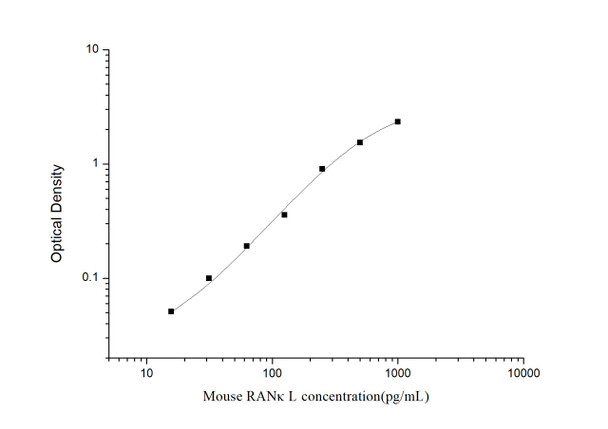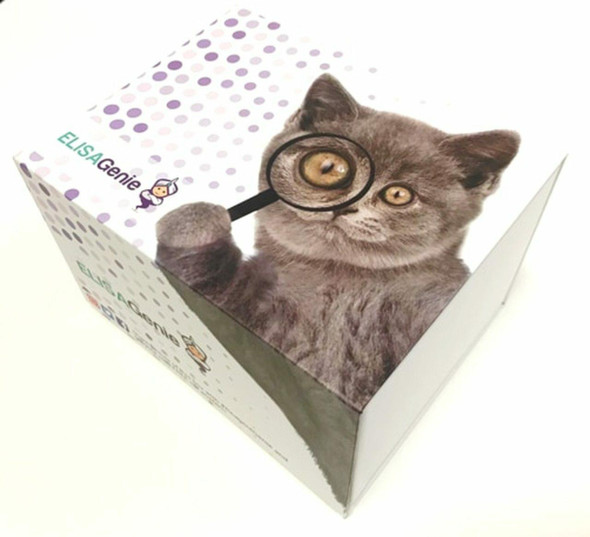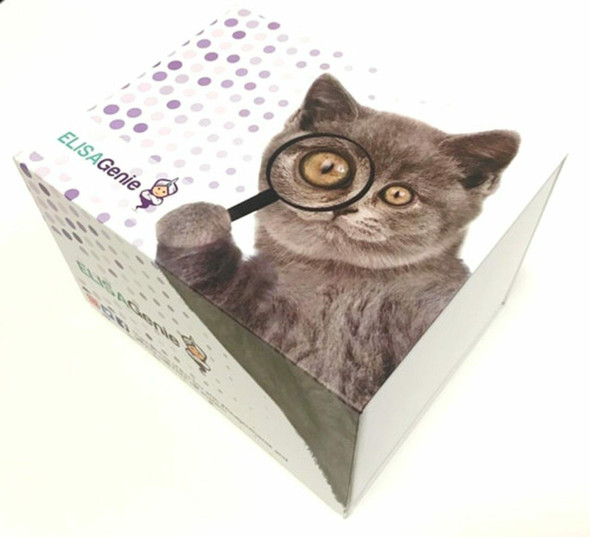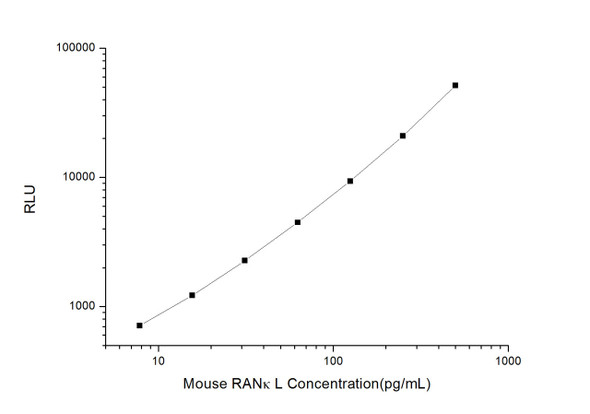Mouse Developmental Biology ELISA Kits
Mouse RANkL (Receptor Activator of Nuclear Factor Kappa B Ligand) ELISA Kit (MOES01151)
- SKU:
- MOES01151
- Product Type:
- ELISA Kit
- Size:
- 96 Assays
- Uniprot:
- O35235
- Sensitivity:
- 9.38pg/mL
- Range:
- 15.63-1000pg/mL
- ELISA Type:
- Sandwich
- Synonyms:
- TNFSF11, TRANCE, RANKL, CD254, ODF, OPGL, OPTB2, hRANKL2, sOdf
- Reactivity:
- Mouse
- Sample Type:
- Serum, plasma and other biological fluids
- Research Area:
- Developmental Biology
Description
| Assay type: | Sandwich |
| Format: | 96T |
| Assay time: | 4.5h |
| Reactivity: | Mouse |
| Detection Method: | Colormetric |
| Detection Range: | 15.63-1000 pg/mL |
| Sensitivity: | 9.38 pg/mL |
| Sample Volume Required Per Well: | 100µL |
| Sample Type: | Serum, plasma and other biological fluids |
| Specificity: | This kit recognizes Mouse RANkL in samples. No significant cross-reactivity or interference between Mouse RANkL and analogues was observed. |
This ELISA kit uses Sandwich-ELISA as the method. The micro ELISA plate provided in this kit has been pre-coated with an antibody specific to Mouse RANkL. Standards or samples are added to the appropriate micro ELISA plate wells and combined with the specific antibody. Then a biotinylated detection antibody specific for Mouse RANkL and Avidin-Horseradish Peroxidase (HRP) conjugate are added to each micro plate well successively and incubated. Free components are washed away. The substrate solution is added to each well. Only those wells that contain Mouse RANkL, biotinylated detection antibody and Avidin-HRP conjugate will appear blue in color. The enzyme-substrate reaction is terminated by adding Stop Solution and the color turns yellow. The optical density (OD) is measured spectrophotometrically at a wavelength of 450 nm ± 2 nm. The OD value is proportional to the concentration of Mouse RANkL. The concentration of Mouse RANkL in samples can be calculated by comparing the OD of the samples to the standard curve.
| UniProt Protein Function: | TNFSF11: Cytokine that binds to TNFRSF11B/OPG and to TNFRSF11A/RANK. Osteoclast differentiation and activation factor. Augments the ability of dendritic cells to stimulate naive T-cell proliferation. May be an important regulator of interactions between T-cells and dendritic cells and may play a role in the regulation of the T-cell-dependent immune response. May also play an important role in enhanced bone-resorption in humoral hypercalcemia of malignancy. Homotrimer. Up-regulated by T-cell receptor stimulation. Highest in the peripheral lymph nodes, weak in spleen, peripheral blood Leukocytes, bone marrow, heart, placenta, skeletal muscle, stomach and thyroid. Belongs to the tumor necrosis factor family. 3 isoforms of the human protein are produced by alternative splicing. |
| UniProt Protein Details: | Protein type:Membrane protein, integral Cellular Component: extracellular space; membrane; cytoplasm; integral to membrane; plasma membrane; extracellular region; intracellular Molecular Function:protein binding; cytokine activity; tumor necrosis factor receptor superfamily binding; tumor necrosis factor receptor binding Biological Process: positive regulation of osteoclast differentiation; multicellular organismal development; positive regulation of JNK cascade; osteoclast differentiation; activation of JNK activity; positive regulation of homotypic cell-cell adhesion; positive regulation of corticotropin-releasing hormone secretion; activation of NF-kappaB transcription factor; calcium ion homeostasis; positive regulation of MAP kinase activity; monocyte chemotaxis; regulation of osteoclast differentiation; tumor necrosis factor-mediated signaling pathway; positive regulation of bone resorption; cell differentiation; protein homooligomerization; bone resorption; ossification; positive regulation of I-kappaB kinase/NF-kappaB cascade; cytokine and chemokine mediated signaling pathway; mammary gland epithelial cell proliferation; lymph node development; positive regulation of protein kinase B signaling cascade; organ morphogenesis; immune response; positive regulation of transcription from RNA polymerase II promoter; positive regulation of transcription factor activity; positive regulation of T cell activation; positive regulation of phosphorylation |
| UniProt Code: | O35235 |
| NCBI GenInfo Identifier: | 342187063 |
| NCBI Gene ID: | 21943 |
| NCBI Accession: | O35235. 2 |
| UniProt Secondary Accession: | O35235,O35306, Q3TWY5, Q9JJK8, Q9JJK9, Q9R1Y0, |
| UniProt Related Accession: | O35235 |
| Molecular Weight: | 22,150 Da |
| NCBI Full Name: | Tumor necrosis factor ligand superfamily member 11 |
| NCBI Synonym Full Names: | tumor necrosis factor (ligand) superfamily, member 11 |
| NCBI Official Symbol: | Tnfsf11 |
| NCBI Official Synonym Symbols: | ODF; OPG; OPGL; RANKL; Ly109l; Trance |
| NCBI Protein Information: | tumor necrosis factor ligand superfamily member 11; OPG ligand; osteoprotegerin ligand; osteoclast differentiation factor; receptor activator of NF-kappaB ligand; TNF-related activation-induced cytokine; receptor activator of nuclear factor kappa B ligand; receptor activator of nuclear factor kappa-B ligand; tumor necrosis factor-related activation-induced cytokine |
| UniProt Protein Name: | Tumor necrosis factor ligand superfamily member 11 |
| UniProt Synonym Protein Names: | Osteoclast differentiation factor; ODF; Osteoprotegerin ligand; OPGL; Receptor activator of nuclear factor kappa-B ligand; RANKL; TNF-related activation-induced cytokine; TRANCE; CD_antigen: CD254Cleaved into the following 2 chains:Tumor necrosis factor ligand superfamily member 11, membrane form; Tumor necrosis factor ligand superfamily member 11, soluble form |
| UniProt Gene Name: | Tnfsf11 |
| UniProt Entry Name: | TNF11_MOUSE |
As the OD values of the standard curve may vary according to the conditions of the actual assay performance (e. g. operator, pipetting technique, washing technique or temperature effects), the operator should establish a standard curve for each test. Typical standard curve and data is provided below for reference only.
| Concentration (pg/mL) | O.D | Average | Corrected |
| 1000 | 2.376 2.436 | 2.406 | 2.341 |
| 500 | 1.582 1.622 | 1.602 | 1.537 |
| 250 | 0.976 0.964 | 0.97 | 0.905 |
| 125 | 0.418 0.426 | 0.422 | 0.357 |
| 62.5 | 0.261 0.251 | 0.256 | 0.191 |
| 31.25 | 0.171 0.159 | 0.165 | 0.1 |
| 15.63 | 0.111 0.121 | 0.116 | 0.051 |
| 0 | 0.064 0.066 | 0.065 | -- |
Precision
Intra-assay Precision (Precision within an assay): 3 samples with low, mid range and high level Mouse RANkL were tested 20 times on one plate, respectively.
Inter-assay Precision (Precision between assays): 3 samples with low, mid range and high level Mouse RANkL were tested on 3 different plates, 20 replicates in each plate.
| Intra-assay Precision | Inter-assay Precision | |||||
| Sample | 1 | 2 | 3 | 1 | 2 | 3 |
| n | 20 | 20 | 20 | 20 | 20 | 20 |
| Mean (pg/mL) | 48.90 | 141.60 | 488.30 | 44.20 | 146.70 | 447.00 |
| Standard deviation | 3.20 | 8.40 | 19.50 | 2.60 | 8.20 | 16.50 |
| C V (%) | 6.54 | 5.93 | 3.99 | 5.88 | 5.59 | 3.69 |
Recovery
The recovery of Mouse RANkL spiked at three different levels in samples throughout the range of the assay was evaluated in various matrices.
| Sample Type | Range (%) | Average Recovery (%) |
| Serum (n=5) | 83-98 | 90 |
| EDTA plasma (n=5) | 92-104 | 98 |
| Cell culture media (n=5) | 84-99 | 91 |
Linearity
Samples were spiked with high concentrations of Mouse RANkL and diluted with Reference Standard & Sample Diluent to produce samples with values within the range of the assay.
| Serum (n=5) | EDTA plasma (n=5) | Cell culture media (n=5) | ||
| 1:2 | Range (%) | 98-114 | 98-112 | 91-103 |
| Average (%) | 106 | 105 | 98 | |
| 1:4 | Range (%) | 95-109 | 83-97 | 93-106 |
| Average (%) | 103 | 90 | 99 | |
| 1:8 | Range (%) | 94-107 | 81-93 | 92-106 |
| Average (%) | 101 | 87 | 100 | |
| 1:16 | Range (%) | 99-116 | 82-92 | 95-108 |
| Average (%) | 107 | 86 | 102 |
An unopened kit can be stored at 4°C for 1 month. If the kit is not used within 1 month, store the items separately according to the following conditions once the kit is received.
| Item | Specifications | Storage |
| Micro ELISA Plate(Dismountable) | 8 wells ×12 strips | -20°C, 6 months |
| Reference Standard | 2 vials | |
| Concentrated Biotinylated Detection Ab (100×) | 1 vial, 120 µL | |
| Concentrated HRP Conjugate (100×) | 1 vial, 120 µL | -20°C(shading light), 6 months |
| Reference Standard & Sample Diluent | 1 vial, 20 mL | 4°C, 6 months |
| Biotinylated Detection Ab Diluent | 1 vial, 14 mL | |
| HRP Conjugate Diluent | 1 vial, 14 mL | |
| Concentrated Wash Buffer (25×) | 1 vial, 30 mL | |
| Substrate Reagent | 1 vial, 10 mL | 4°C(shading light) |
| Stop Solution | 1 vial, 10 mL | 4°C |
| Plate Sealer | 5 pieces | |
| Product Description | 1 copy | |
| Certificate of Analysis | 1 copy |
- Set standard, test sample and control (zero) wells on the pre-coated plate and record theirpositions. It is recommended to measure each standard and sample in duplicate. Note: addall solutions to the bottom of the plate wells while avoiding contact with the well walls. Ensuresolutions do not foam when adding to the wells.
- Aliquot 100µl of standard solutions into the standard wells.
- Add 100µl of Sample / Standard dilution buffer into the control (zero) well.
- Add 100µl of properly diluted sample (serum, plasma, tissue homogenates and otherbiological fluids) into test sample wells.
- Cover the plate with the sealer provided in the kit and incubate for 90 min at 37°C.
- Aspirate the liquid from each well, do not wash. Immediately add 100µL of BiotinylatedDetection Ab working solution to each well. Cover the plate with a plate seal and gently mix. Incubate for 1 hour at 37°C.
- Aspirate or decant the solution from the plate and add 350µL of wash buffer to each welland incubate for 1-2 minutes at room temperature. Aspirate the solution from each well andclap the plate on absorbent filter paper to dry. Repeat this process 3 times. Note: a microplatewasher can be used in this step and other wash steps.
- Add 100µL of HRP Conjugate working solution to each well. Cover with a plate seal andincubate for 30 min at 37°C.
- Aspirate or decant the solution from each well. Repeat the wash process for five times asconducted in step 7.
- Add 90µL of Substrate Reagent to each well. Cover with a new plate seal and incubate forapproximately 15 min at 37°C. Protect the plate from light. Note: the reaction time can beshortened or extended according to the actual color change, but not by more than 30min.
- Add 50 µL of Stop Solution to each well. Note: Adding the stop solution should be done inthe same order as the substrate solution.
- Determine the optical density (OD value) of each well immediately with a microplate readerset at 450 nm.






